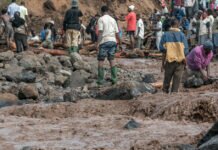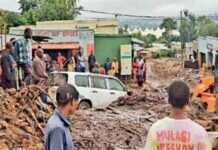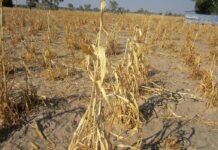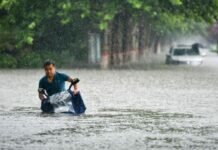
Record-breaking rainfall induced by tropical cyclones has caused devastation and casualties in the Chinese capital Beijing and the surrounding province of Hebei, prompting a major relief and rescue operation.
Beijing recorded its heaviest rainfall over the past few days since records began 140 years ago. It logged 744.8 millimeters of rain, the maximum amount of precipitation recorded during the rainstorm, between 8 p.m. on Saturday 29 July and 7 a.m. Wednesday 2 August at a city reservoir, according to the Beijing Meteorological Service in a report cited by the Xinhua News Agency.
There were reports of more than a dozen casualties, with more than 125,000 people evacuated. Dramatic photos and film footage showed images of roads turned into rivers, sweeping away infrastructure and cars.
‘’The disaster is just the latest in a series of high-impact events which have affected Asia and other parts of the globe this summer, including extreme rainfall and dangerous heat,” said Dr Johan Stander, director of WMO Services Department. “We see evidence literally on a daily basis of the urgency of the UN Early Warnings for All intiative to ensure that everyone on Earth has access to life-saving early warnings.”
Typhoons Doksuri and Khanun
The rainfall was triggered by the powerful Typhoon Doksuri, which left a trail of destruction as moved from the Philippines and made landfall in the southeastern province of Fujian on 29 July. The massive rain banks of this powerful typhoon stretched as far north as Beijing and in areas along the Yellow and Huaihe rivers.
Meteorological authorities in both the Philippines and China issued their highest level of alert and ordered the suspension of maritime, land and air transport for Doksuri, the fifth named storm of the Pacific tropical cyclone season. Dozens of casualties were reported in the Philippines.
Chinese President Xi Jinping demanded all-out search and rescue of the people missing or trapped in floods and geological disasters in an instruction on the work regarding flood prevention and disaster relief.
Xi Jinping demanded that all localities should make all-out efforts to search for and rescue missing and trapped people, do a good job in treating the injured and comforting the families of the victims, and minimize casualties. It is necessary to properly resettle the disaster-stricken people, pay close attention to repairing damaged infrastructure such as transportation, communications, and electricity, and restore normal production and living order as soon as possible.
Xi Jinping stressed that at present, in the critical period of “seven lower and eight upper” flood control, all regions and relevant departments must attach great importance to and compact their responsibilities, strengthen monitoring, forecasting and early warning, strengthen patrol duty, pay close attention to key flood prevention parts, implement various flood prevention measures, and make every effort to ensure the safety of people’s lives and property and the overall stability of society.
The torrential rainfall also lashed Beijing’s surrounding Hebei province, leading to the swelling of rivers, damaging bridges and prompting the evacuation of people. Hebei renewed an orange alert for rainstorms on Tuesday.
A new large and very strong typhoon, Khanun caused destructive winds and torrential rainfall in the Japanese island of Okinawa, according to WMO’s Regional Specialized Meteorological Center, the Tokyo Typhoon Center. Although it is not forecast to make landfall in China, there are warnings of storm tides hitting the coastal areas of east China’s Zhejiang Province. Nearly 200,000 people were reportedly evacuated and more than 14,000 rescue workers are on standby, according to Zhejiang’s provincial flood control and drought relief headquarters.
Extreme rainfall
There have been a series of extreme rainfall events in Asia in recent weeks.
Forty people were reported killed as torrential rain and flash floods hit the Republic of Korea on 14 July.
In northern India, roads and bridges collapsed and houses were swept away as rivers overflowed during heavy monsoonal rainfall and flooding which killed dozens of people. The mountainous state of Himachal Pradesh was badly hit, as were the regions of Punjab, Rajastan and Uttar Pradesh. New Delhi reportedly marked its wettest July day in 40 years, with 153 millimeters (6 inches) of rain falling in one day.
The Japanese Meteorological Agency (JMA) issued heavy rain emergency warnings on Monday for the Fukuoka and Oita prefectures, on Kyushu, the country’s third largest island. A new daily rainfall record of 376.0 mm fell on 10 July at Minousan and 361.5 mm at Hikosan, both in the Kyushu region.
“As the planet warms, the expectation is that we will see more and more intense, more frequent, more severe rainfall events, leading also to more severe flooding,” said Dr Stefan Uhlenbrook, Director of hydrology, water and cryosphere at WMO.
Asia is particularly vulnerable to water-related hazards. According to WMO’s report on the State of the Climate in Asia 2022, there were 81 major natural hazard events in the region last year, of which 83% were flood and storm events.
These events led to over 5 000 fatalities, 90% of which were associated with flooding. Overall, natural hazard events directly impacted more than 50 million people and resulted in over US$ 36 billion in damages.












































